
|   |

|   |
Gunjan Dance Academy celebrates 17th Annual festival - Dr Sunil Kothari e-mail: sunilkothari1933@gmail.com Photos courtesy: Gunjan November 27, 2013 Meera Das, senior disciple of Guru Kelucharan Mohapatra based in Cuttack assiduously continues Odissi training at Cuttack, though the dance scene has shifted to the capital Bhubaneswar in a big way. Kala Vikash Kendra, the premier institution started training of Odissi dance at Cuttack, where Kelucharan Mohapatra taught Odissi to several young dancers, including Kum Kum Mohanty (nee Das), conducted workshops when dancers from different parts of India and some from abroad came to study Odissi. Later, Odissi Research Centre was established at Bhubaneswar and many Odiya dancers studied there under Kelubabu, including Meera Das, who did not settle down in Bhubaneswar. She chose to open her institution Gunjan Dance Academy at Cuttack in 1995 and has trained more than 200 young dancers at her academy. Last year I had attended its 16th annual festival and was impressed by her dedication and determination to carry on the legacy of her guru in Cuttack. Once upon a time it was Kala Vikash Kendra which drew many to its portals to study Odissi. Today, Meera Das with her dynamism and catholic outlook has succeeded in keeping the interest among people in Cuttack alive in Odissi through her academy and several events she organizes. The three day dance and music festival she conducts features well known dancers practicing different classical dance forms and provides platform to young up and coming talented dancers as well. With a band of her dedicated supporters, including her President Gayatri Das, local committee members, her senior students, some of whom with thorough training under her, also take classes, teach and perform, and poet and critic Kedar Mishra, Meera Das continues to run her academy successfully. The festival opened at Shaheed Bhavan auditorium on 18th November with Jagannath Mangalam choreographed by Meera Das for the students hailing Lord Jagannath's blessings, evoking auspicious feelings. Using dancers one standing behind the other creating an illusion of four armed Vishnu, holding chakra, shankha, gada and padma, delineating further image of Lord being drawn in a chariot with Pahandi chal, using traditional music with ghanta, jhanz and mardala, dancers performing joyously, the mood was set. This year from Kiev, Ukraine, Ganna Smirnova, a disciple of Jayalakshmi Iswar presented two Bharatanatyam items of Kalakshetra bani. Jayami, as Jayalakshmi Iswar, a former senior alumnus of Kalakshetra is known, has groomed Ganna well. She has imbibed the spirit of Bharatanatyam with intensity and succeeds in transcending physical looks of a foreigner. She has been studying under Jayami since 2000 under ICCR fellowship and regularly visits India for training and performances in various festivals. She runs her own dance academy Nakshatra at Kiev. She chose to present abhinaya to an ashtapadi from the Gita Govinda in which the Sakhi tells Krishna how Radha suffers from her separation from him. As Vaskasajja nayika, she is awaiting his arrival, looking for him and mistakes images of him in whatever she looks at. 'Sidati Radha vasagrihe,' Radha suffers in her bower. Set to Desh raga and rendered by O.S. Sreedhar it brought out the agony of Radha in a poignant manner. Ganna performed tillana set to Revati raga and adi tala composed by Madurai N Krishnan, revealing Kalakshetra bani faithfully. Her humility and grasp of the aesthetics of the dance form is praiseworthy. I have seen her performances both in Kiev and in India at many conferences and appreciate her approach. It was a pleasure to see her maintaining the style and performing it so well. 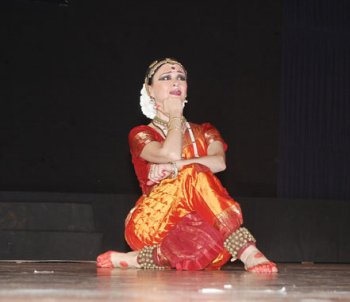 Ganna Smirnova 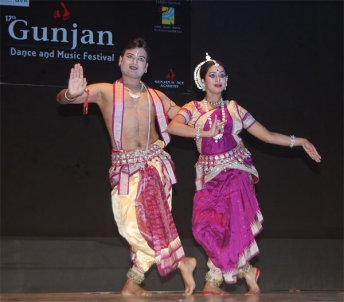 Ramesh & Madhusmita In order to showcase the tiny tots named as Little Angles of Gunjan Academy, Meera presented them in a group composition 'Sarva Mangala.' In a disciplined manner the youngest ones stole the show with correct chauka position, holding their raised arms correctly and forming various circles, groupings, uncluttered entries and exits giving audience an idea of how training in dance is given at the Academy. To handle tiny tots is not an easy job. Meera Das's senior dancers who assisted her were given due recognition when all took curtain call. Odissi duet by Madhusmita, disciple of Aruna Mohanty, and Ramesh, Madhusmita's husband trained by Gangadhar Pradhan and Aruna Mohanty dwelt on Navarasa using sequences from Ramayana from shringara to shanta. Both are accomplished dancers and as a couple have shown complimentary plus points in their depiction of the narrative and impersonation of various characters like Ravana, Jatayu to name a few. Karunya seeing Jatayu's condition was well enacted and chosen. But of late, some of us critics do not like depiction of Surpanakha for hasya rasa. She is being ridiculed as a woman, which seems politically incorrect. It would help Ramesh and Madhusmita to re-choreograph that incident in a more dignified manner. Bibhatsa seeing skulls and corpses on battlefield and vultures eating their flesh was impressive. Both are polished dancers and their presentation was highly aesthetic. Disciple Malabika Jena's solo Odissi for eighth ashtapadi from the Gita Govinda, sakhi asking Radha to go to Kelisadan, Krishna's bower -'anusara Radhike' for 'suchita Haripariranbhanam' for union with Lord Krishna, set to the music by scholar and musicologist Subas Pani saw her enacting bhavas modestly, becoming a young nayika. She sculpted various postures in Odissi bringing the nayika alive. The program concluded with sub-junior dancers of the Academy performing to Shanti Mantra in form of Moksha where all elements from vayu, akash, bhumi, jala, vansapti were invoked praying for peace. Keeping with Meera Das's patient training for juniors ranging from 7 to10 years, the group dance was impressive. The dancing and innocence of the little ones always tugs at the hearts of elders. On the second day on 19th morning, a seminar was held at the premises of Gunjan Dance Academy, conceived and moderated by Kedar Mishra, with a provocative title 'Contextualizing modernity in Indian classical Odissi dance' with participation from critic Leela Venkataraman, Madhavi Puranam, Managing editor of quarterly Nartanam, myself and dancers participating in the festival - Bharatanatyam exponents Ganna Smirnova from Kiev and Poornima Ashok from Bangalore, Rahul Acharya, Nityanand Mishra, Aruna Mohanty from Bhubaneswar and disciples of Meera Das. 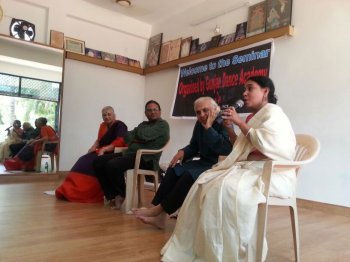 Seminar Leela Venkataraman spoke of prescriptive norms of Natyasastra which permits dancers to explore and create their own works, and according to the times the modern works also become classical. In clear terms and with great clarity, she placed the problem in right perspective. Kedar Mishra quoted from poet Elliot and wanted to know how dancers look at this problem. All agreed that in their times, what Guru Kelucharan Mohapatra and other gurus were creating in Odissi was at that time modern and now has acquired classical status. Aruna Mohanty observed that today the climate was more open and dancers meet other dancers and interact and appreciate what they create. Rahul Acharya spoke of Yogavashistha and how norms could be judged for traditions. Nityananda Mishra in lighter vein said that Sanskrit was the most modern language as the plays also used Prakrit language. Ganna Smirnova gave her views of Western aesthetics and how she finds vishranti in classical Indian aesthetics and dance forms. Poornima Ashok focused on how she resolved issue of modernity with technique and also exploring tani avartanam of classical Carnatic music to tell story of Natyasastra and its further development. Madhavi Puranam placed responses of different audiences and senior disciples of Meera Das explained that they would like to follow tradition as handed down to them but also explore new themes. It was a very interesting seminar and credit goes to Kedar Mishra for conceiving it and provoking participants to think. 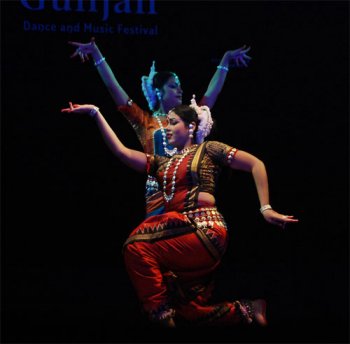 Pushpa Panda and Shibani Parija 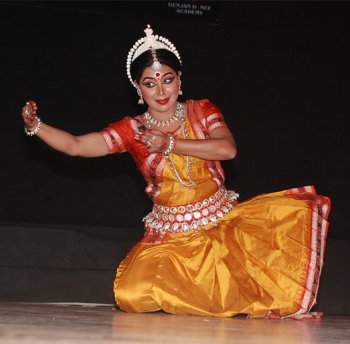 Aruna Mohanty In the evening, the junior students of Gunjan presented Gayatri mantra in group dance. It was followed by duet Shringara choreographed by Meera Das and performed by Pushpa Panda and Shibani Parija. They set back to back and with various sculpturesque positions depicted feeling of joy suggesting emotion of shringara. In pure dance item Nritta by juniors of Gunjan they explored sculptures of musicians playing veena, mardala, manjira and venu often seen in Batu item and brought the sculptures to life through movements. However the highlight of the evening was a solo by seasoned dancer Aruna Mohanty who presented Varsha Abhisar using Odiya poems and Kalidasa's verses dovetailing appropriately Megh raga. Some of the choreography looked like segments of pallavi in druta, fast tempo employed artistically. The choreography of Mahashunya (void) reminding of Nasadiya sukta, in collaboration with Kedar Mishra was the piece de resistance, displaying what imaginative choreography Aruna is capable of creating for such an abstract theme. There was nothing in the beginning, no sun, no moon, no tangible or intangible objects, no water, no air and then creation took place. 'Surya Chakshu, Chandrama scha, punarnava Agni scha chakra, tasmai sthayai Brahamane namaha' - with one stroke of imagination she created religions showing Budhha, praying namaz, carrying cross, taking chauka and suggesting Lord Jagannatha. The text of poet Bhim Bhoi was explored with great intensity. The musicians' support was exemplary. This collaborative work by Aruna Mohanty showed that the younger generation of dancers is creating wonders. Aruna's explorations in Odissi place her in a class of her own. Bravo Aruna! Moods of Rhythm by seniors of Gunjan dealt with sounds of various musical instruments with varied sound textures. At times, dancers wielded real manjiras, creating melodious sounds. Mridanga, khanjani, mardala were shown through movements like parshva mardala as seen in sculptures. Dancers also clapped with palms. The choreographic number gave scope to dancers to depict variety of musical instruments as seen in Orissan sculptures and explore the textures of sound. Except that at times it looked repetitive. A tight editing would help. 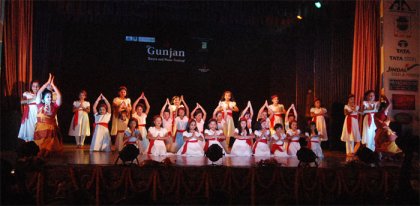 Gunjan group 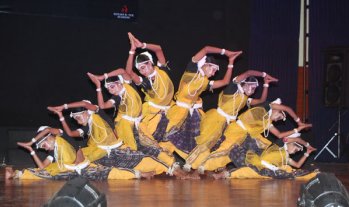 Gotipua dancers Bijay Sahoo and his group Nakshatra with the gotipua dancers literally brought down the house, with their breathtaking acrobatic feats and mindboggling ability to climb upon one another forming human pyramids winning rounds of applause from the audiences who invariably are awe struck seeing their skill - their somersaults, landing pat on the sam, getting up in quick succession, and completely at ease performing without any self consciousness. There are now several gotipua groups and young gotipua gurus have been training children systematically. Having seen gotipua dances for many years, I find that the concentration has shifted to acrobatic feats only, and abhinaya to the songs is taking a back seat. I would suggest that senior dancers guide them and lay equal emphasis on the songs and abhinaya, which have its own delicious appeal as their young minds and bodies dance in a manner which has its own charm. I have been requesting Kedar Mishra and Shyamhari Chakra to undertake a project and collect innumerable songs with exquisite emotions of perennial appeal. Also the organizers should insist when inviting gotipua groups to include abhinaya songs along with acrobatic feats. On the concluding day, Janaki Vallabh Pattnaik, Governor of Assam, and Mrs. Pattnaik graced the occasion and recalled the early beginnings of Odissi in Cuttack. The couple has known Meera Das from her childhood displaying interest in dance. They always encouraged her and were happy to see the progress Meera Das and her Gunjan Dance Academy have made over the years. On this occasion at the hands of the Governor, the mardala wizard Banamali Maharana was honoured with Nibedita Patnaik Samman 2013 with a cheque of Rs 10,000. Banamali Maharana is a legend and his contribution to the percussion music for Odissi is most valuable. Self effacing and simple, Banamali has carried on giving his knowledge generously to the young generation building a sound base of Odissi percussion music. Meera Das had specially choreographed Shri Rama Prema Bhakti Katha on this occasion, in consultation with Kedar Mishra selecting choice verses from Baidehi Bilas and Odiya Ramayana. Meera played the role of Lord Rama with her customary finesse and command over technique. There were more of Tualasidas's Rama Charit Manas chaupais, perhaps as a concession to popular appeal. The Kaivat prasang, Ahalya's coming to life at touch of Rama's feet, Sabari's love for Rama offering her fruits after testing, Lakshmana's getting annoyed at it, but Rama assuring him of Sabari's devotion et al were presented in quick succession. Though one wondered why Sabari was shown very young and not emaciated with age frail in appearance. Since I recall the chaupais, like many in the audience, I enjoyed them: "Sarasij lochan jatamukut shir urmala, Shyam gaur sundar do bhai bahu vishala" describing the physical beauty of two brothers, and when offering the fruits, Sabari is seen testing them: "Kand mul phool sarasa ati Sri Rama, prem sahit prabhu khaye varam vara." Ravana's kidnapping Sita, fight with Jatayu and final battle with Ravana, were performed in succession and the presentation ended with Sanskrit shlokas: "Yasya padapadma renu dharakam, Ravanadi shatrudarpa ghatakam tam namami Ramachandram, bhaktajana premvatsal Ramam." As a khyata kathavastu well known story, Meera Das's Ramayana had indeed special appeal. By a happy coincidence, Poornima Ashok, a disciple of Radha Sridhar, Dhananjayan, and Kalanidhi Narayanan, also chose to present in Bharatanatyam excerpt from her solo based on Rama and Sita's first meeting. Titled Madhur Milan, it had melodious and evergreen chaupais of Tulasidas. Describing the Vasant ritu, Spring to the melodious singing by late Jahnavi Jayaprakash, Poornima enacted the joyous atmosphere, Rama and Lakshmana's walking through the garden, Sita's going to Goddess Gauri's darshan and accidently Rama and her looking at each other, Tulasidas describing it "... viloki Prabhu .. Kankan kinkini nupoor dhuni suni rahat lakhan sar aavat Rama hridayguni.. chitavan chakit kaha rahe gaye nrupa kishoran jaga vilokan kamalasruta shreni..." Poornima with her mobile visage registered the delicate and subtlest emotions reflecting the poetry of Tulasidas with consummate artistry. 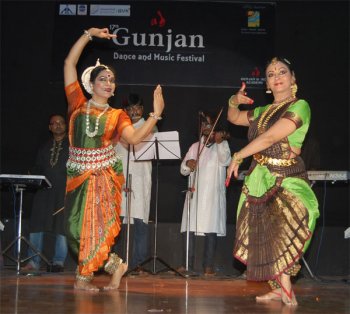 Meera Das & Poornima Ashok Earlier in the beginning, Poornima presented 'Bho Shambho' to Balamuralikrishna's music weaving in episodes of Bhagirath requesting Ganga to descend upon earth, its being received in jata of Lord Shiva, and depicted iconic images of the Lord with description of Trinayana, Chandrachooda, Karunamurte, Vibhuti dharana Vibho, Uma Mahesh, and finally singing and praying, the devotee is lost in seeing the Lord with closed eyes. Poornima danced it intensely with devotional mood. Sushmita Panda, a young disciple, performed abhinaya number 'Jamuna ku Jana..' describing Gopi's plight at Krishna's pranks, Krishna stealing her clothes when she bathes in Jamuna, and her helplessness whenever she looks at him as Sundara Banamali, with Shikha puchha vame dhali dhali, with peacock feather bending on the left- his indescribable beauty. Sushmita needs to develop more accurate body language when enacting abhinaya as saushthava, proper bhangis would look more attractive. Like last year when Ramhari Das presented Vadyavrinda, this year Meera Das invited Srinibas Satpathy and group to present their musical work both in terms of classical and also experimental. Srinibas is a gifted flautist and his accompaniment to Odissi dancers is much appreciated. In his musical composition he shows imaginative approach, but he still has to develop further. The surprise item Meera Das keeps at the end with invited dancers from other classical dance forms. Termed Samagam for union of Odissi, Bharatanatyam and live music by Srinibas Satapathy's orchestra, Meera using Odissi movements, Poornima complimentary Bharatanatyam movements and turning to theme like rain, lightning and nature, animals and suggesting harmony among all, the three day festival of dance and music came to an end. Since I attended two festivals I would like to offer few suggestions. It is important to have showcasing of young junior, little angels and senior disciples of Gunjan Academy to display their talent and what the academy has achieved within a year. In case of junior, tiny tots presentation, parents do attend and love to watch their children perform. But many times, once the children have performed, they leave the auditorium. It is important to expose all students to watch other classical dance forms and senior seasoned dancers of Odissi from within Odisha and elsewhere. With consultation with parents this problem should be solved. Also if it works out, a special annual day could be kept for children and for three day festival, from the annual day some artistes be selected, so the presence of parents will help children to get exposure to other forms.  Dr. Sunil Kothari is a dance historian, scholar, author and a renowned dance critic. He is Vice President of World Dance Alliance Asia Pacific India chapter, based in New Delhi. He is honored by the President of India with Padma Shri, Sangeet Natak Akademi award and Senior Critic Award from Dance Critics Association, NYC. He is a regular contributor to www.narthaki.com, the roving critic for monthly magazine Sruti and is a contributing editor of Nartanam for the past 12 years. Post your comments Pl provide your name and email id along with your comment. All appropriate comments posted with name and email id in the blog will also be featured in the site. |